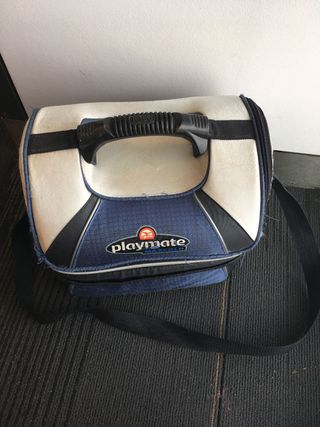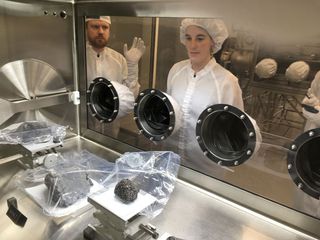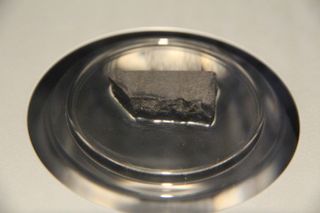Moon Rock Flies to Canada in a Lunch Box for New Exhibit

MONTREAL — One does not simply walk out of NASA with a moon rock, of course.
Sara Arsenault, an employee of the Montreal Science Centre, told Space.com she was so nervous while carrying her precious cargo in April that she missed her first flight back from NASA's Johnson Space Center in Houston, forcing her to try again.
The 24-gram (0.8 ounces) centerpiece of a new museum exhibit was carefully placed inside a lunch box bag so as not to draw the attention of fellow passengers. Customs officials, however, were justifiably suspicious and scrutinized an explanatory letter NASA sent with her, Arsenault said last Friday (July 20). "And on top of that, I was so worried I'd forget it in a taxi or something," she recalled. [Should We Open Some Sealed Apollo Moon Samples?]
Despite her adventures, Arsenault made it back to Montreal safely with her fragment of a 3.8-billion-year-old rock from the 1972 human landing mission of Apollo 17 — part of the same set of "touchable" moon rocks that are at institutions such as Space Center Houston and the Smithsonian National Air and Space Museum in Washington, D.C., she said.
Arsenault turned down the chance to touch a moon rock during her tour at Space Center Houston. "I wanted this rock to be my first one," she said, gesturing at the new exhibit — which was already attracting a crowd of visitors on its first afternoon in the museum on July 20. The exhibit was timed to open on the 49th anniversary of the first human moon landing by the crew of Apollo 11 in 1969.

Water across the universe
Arsenault is the project manager of development and production at the Montreal Science Centre, which attracts roughly 700,000 visitors a year — with half of those coming during the summer months. The museum is located in Montreal's bustling Old Port on the St. Lawrence Seaway, which serves as a major shipping lane in Canada.
Water is everywhere in this Montreal neighborhood, but on the moon, there also is plenty — perhaps enough to host a colony of astronauts. Multiple missions have found evidence of hydrogen on the surface, which scientists interpret as a signature of water ice. Long-term research from NASA's Lunar Reconnaissance Orbiter and a 2017 map generated from past LCROSS (Lunar Crater Observation and Sensing Satellite) information have mapped water in detail for possible future landing missions.
Get the Space.com Newsletter
Breaking space news, the latest updates on rocket launches, skywatching events and more!
Back in 1969, nobody imagined there would be water on the moon, Arsenault said, let alone on other worlds in the solar system. Now we know it's abundant — spurting out of cracks in Saturn's moon Enceladus, hiding in permanently shadowed areas on Mercury, even lingering in the atmosphere of Jupiter after fragments of Comet Shoemaker-Levy 9 crashed there in 1994.

The new Montreal museum exhibit highlights a few locations for water in the solar system. As it orbits Earth, Canada's Radarsat-2 satellite maps the first few inches of soil, providing a snapshot of how the location of water is shifting with climate change. NASA's Mars Phoenix mission of 2008 (in which Canada participated) looked at water ice at the north pole of Mars. Water's link to life is shown in a 3.77-billion-year-old rock from northern Quebec, with probable fossils inside — among the oldest known on Earth. (A study on the Quebec rocks drew international attention in 2017, when the find was first announced.)
Museum officials also threw in some space hardware to attract the attention of visitors, even though the hardware is not necessarily directly related to water. This includes a model of the robotic Canadarm that used to be on display at a facility of Canadian manufacturer MDA, as well as one of the Apollo lunar module landing legs manufactured by Montreal's Héroux-Devtek (formerly known as Héroux).
Museum spokesmen say that the center has plans for the 50th anniversary of Apollo 11 in 2019, but the details have yet to be finalized. That anniversary will probably be a popular day for space museums across North America. The Apollo 11 command module will be at The Museum of Flight in Seattle that day, as part of an ongoing Smithsonian tour. The Smithsonian itself traditionally plans programming around Apollo 11 five-year anniversary milestones; it also is refreshing its moon exploration exhibit for 2020.
Follow us @Spacedotcom, Facebook and Google+. Original article on Space.com.
Join our Space Forums to keep talking space on the latest missions, night sky and more! And if you have a news tip, correction or comment, let us know at: community@space.com.

Elizabeth Howell (she/her), Ph.D., is a staff writer in the spaceflight channel since 2022 covering diversity, education and gaming as well. She was contributing writer for Space.com for 10 years before joining full-time. Elizabeth's reporting includes multiple exclusives with the White House and Office of the Vice-President of the United States, an exclusive conversation with aspiring space tourist (and NSYNC bassist) Lance Bass, speaking several times with the International Space Station, witnessing five human spaceflight launches on two continents, flying parabolic, working inside a spacesuit, and participating in a simulated Mars mission. Her latest book, "Why Am I Taller?", is co-written with astronaut Dave Williams. Elizabeth holds a Ph.D. and M.Sc. in Space Studies from the University of North Dakota, a Bachelor of Journalism from Canada's Carleton University and a Bachelor of History from Canada's Athabasca University. Elizabeth is also a post-secondary instructor in communications and science at several institutions since 2015; her experience includes developing and teaching an astronomy course at Canada's Algonquin College (with Indigenous content as well) to more than 1,000 students since 2020. Elizabeth first got interested in space after watching the movie Apollo 13 in 1996, and still wants to be an astronaut someday. Mastodon: https://qoto.org/@howellspace
